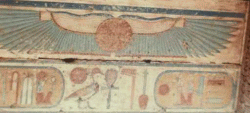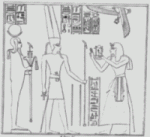![]()
A Short History of Hieroglyphs
The origins of writing in Ancient Egypt are not very well known. Around 3000BC, the hieroglyphs appear, and the system seems to be fully formed at that time. This might be due to a lack of documents. Another hypothesis would be that the Egyptians took the idea of writing from the Sumerian, but this is unsure.
Anyway, the hieroglyphic signs themselves are very different from their cuneiform counterpart, and use pictures of typical nilotic fauna and flora, so most of the system must have been developed in Egypt proper.
The Three Kinds of Signs
To speak broadly, hieroglyphs are of three kinds: phonetic signs, ideograms, and determinatives. The first are used for writing sounds (actually consonants); for example, the sign ![]() is used for the sound ''kheper'' because the scarab is called so; the sign
is used for the sound ''kheper'' because the scarab is called so; the sign ![]() is used for the consonant ''m'' because the word owl starts with an ''m'', and so on... Ideograms are used to write the thing or the idea represented by their drawing. So
is used for the consonant ''m'' because the word owl starts with an ''m'', and so on... Ideograms are used to write the thing or the idea represented by their drawing. So ![]() is used for writing the word ''bull'', and
is used for writing the word ''bull'', and ![]() , the slate of a scribe, is used for writing the word ''scribe.''
, the slate of a scribe, is used for writing the word ''scribe.''
As Egyptian doesn't use space between the words, and doesn't write vowels, this writing would have been very ambiguous, if it hadn't used determinatives. These are signs used as a word-ending, to specify the semantic category of a word. For example, the signs ![]() read ''iew''. But that might be the verb ''to lament'', or the substantives ''dog'' or ''wrongdoing''. So three different determinatives are used:
read ''iew''. But that might be the verb ''to lament'', or the substantives ''dog'' or ''wrongdoing''. So three different determinatives are used: ![]() , which designates any action of the mouth,
, which designates any action of the mouth, ![]() for dogs, and
for dogs, and ![]() , a sign used for small and evil things alike. So the word
, a sign used for small and evil things alike. So the word ![]() means ''to lament,'' whereas
means ''to lament,'' whereas ![]() means ''dog'' and
means ''dog'' and ![]() means ''wrongdoing''.
means ''wrongdoing''.
The Phonetic Signs
The phonetic signs themselves can be separated into different classes, according to the number of consonants they write. The most used signs are the uniliteral signs which, as their names state, represent one consonant. Had the Egyptians restricted themselves to these signs, they would have used an alphabetic writing, but they did not. And, contrarily to what a naive view of evolution might suggest, their system was closer to an alphabetic writing in the sixth dynasty than in the ptolemaic times. The uniliteral signs are shown in table 1.
Along with these signs, biliteral and triliteral signs, representing respectively two and three consonants were used. Most of the time, some of the consonant represented by the sign were written twice, once with the bi- or tri-literal sign, and once with a uniliteral sign. For example, the biliteral sign ![]() is to be read
is to be read ![]() , and
, and ![]() is
is ![]() . But
. But ![]() reads
reads ![]() and not
and not ![]() .
.
This had some aesthetic uses, but was mainly important in hieratic, the very cursive script used in everyday life, where it was easier to misinterpret signs. The redundancy achieved thanks to the supplementary uniliteral signs allowed to distinguish similar looking signs.
Table 1: Alphabetical signs
|
Source:
Serge Rosmorduc
The determinatives
These signs acted as semantic classifiers. We have already seen that they helped to determine where a word ends. But they had more important use. In semitic languages, the word roots are based on the consonantic skeleton of the word, but the grammatical value of a word depends on the vowels. The same is true in Egyptian, particularly for verbs. Sometimes, specially when the word contains weak consonants, as or , the apparent consonantic skeleton of the verb changes with its uses. But often, no external change allows us to tell one form from another. Then, sometimes, the addition of determinatives helps. For example, the root ![]() ,
, ![]() , conventionally pronounced ''bak'', is connected with the idea of ''working''. So, with the determinative of actions,
, conventionally pronounced ''bak'', is connected with the idea of ''working''. So, with the determinative of actions, ![]() ,it writes the verb ''to work'':
,it writes the verb ''to work'': ![]() .
.
With the sign of the man, ![]() , it writes the word ''servant'':
, it writes the word ''servant'': ![]() .The word
.The word ![]() , with the sign of plural or collective things (three ticks), meant ''work'', ''task''; but with the determinative of abstract things, the papyrus-roll
, with the sign of plural or collective things (three ticks), meant ''work'', ''task''; but with the determinative of abstract things, the papyrus-roll ![]() , you get the word
, you get the word ![]() , which means ''workmanship''.
, which means ''workmanship''.
Determinatives are also useful for the reader when an unknown word is met. Signs like ![]() , found after a strange word, indicates that it's probably the name of a foreign country. The sign represents a range of mountains like the gebels which surround Egypt, and are so associated with the idea of foreign landscape.
, found after a strange word, indicates that it's probably the name of a foreign country. The sign represents a range of mountains like the gebels which surround Egypt, and are so associated with the idea of foreign landscape.
Finally, they give us an idea of the notions ancient Egyptians put behind some words: joy, ![]() , angriness,
, angriness, ![]() ,or
,or ![]() ...
...
Sign grouping
The basic rule of Middle Egyptian writing is ''scribes hate voids''. So the signs tend to fill the available space. Compare the following text:
![]()
with the way it's really written:
![]()
The aesthetic considerations are very important in hieroglyphs. Sometimes, sign-order is changed for the sake of space-filling only. For writing ![]() , ''this'', the normal form is
, ''this'', the normal form is ![]() , but a space is left after the bird. So, the word is often written:
, but a space is left after the bird. So, the word is often written: ![]() .
.
Direction of Writing
The normal direction of writing for ancient Egyptian was right-to-left, which may be due to the use of papyrus rolls. But the pictorial nature of the hieroglyphs allowed them to be easily reversed. So, the texts could be written in both directions, with, however a preference for right-to-left.
Normally, the hieroglyphs that represent animated beings look toward the beginning of the text. So:
![]() is to be read left-to-right, but
is to be read left-to-right, but
![]() is to be read right-to-left
is to be read right-to-left
When the text goes along with representations, its orientation is the same as the one of the figure it accompanies. For example, when a stela is carved with a king making offerings to a god, the god is usually placed on the left, looking to the right, according to the normal orientation for hieroglyphs; the caption and discourses of the god are likewise turned right-to-left. The king making offering is on the right, turned toward the left, and his caption and discourses are turned left-to-right. See for example figure 2.
Of course, when symmetry is wanted (for example, you might find two stelas on each side of a doorway), this system allows inscriptions to be mirrored.
A side effect of this is that the normal orientation for a representation is as thought it was viewed turned towards the right. In such cases, if the representation is shown walking, the most advanced leg must be the left leg, because otherwise it would be partially hidden by the right leg. So, as Egyptian statues were mainly big hieroglyphs, they normally advance the left leg. See for example the figure of Amon on figure 2, or the funerary statue of Mereruka. In the inscription of figure 1, the sign ankh, ![]() ,to be read as ''may ... live'', is shared between two different name of the king Ramses III, one written right-to-left and the other left-to-right . As the sign is symmetric, this is often used. The text translate, left-to-right, beginning with ankh:
,to be read as ''may ... live'', is shared between two different name of the king Ramses III, one written right-to-left and the other left-to-right . As the sign is symmetric, this is often used. The text translate, left-to-right, beginning with ankh:
May the perfect god Heqa-maat-re live
and right to left :
May the son of Re, Ramses-[Heqa-Iunu] live

Figure 1: Ramses III’s name

Figure 2: Ramesses the IVth
offering Maat to Amon and Khonsou
MORE (Deciphering)
[HOME] [AVIATION] [HUMANS] [Paleoanthropology] [Oldest Modern Humans] [Human Skulls] [Cuneiform Inscriptions] [History of Hieroglyphs] [Mesoamerican Writing] [Machu Picchu] [German Stonehenge] [ORIGINS] [SCIENCE] [WEB LINKS] [SITE MAP] [CONTACT]